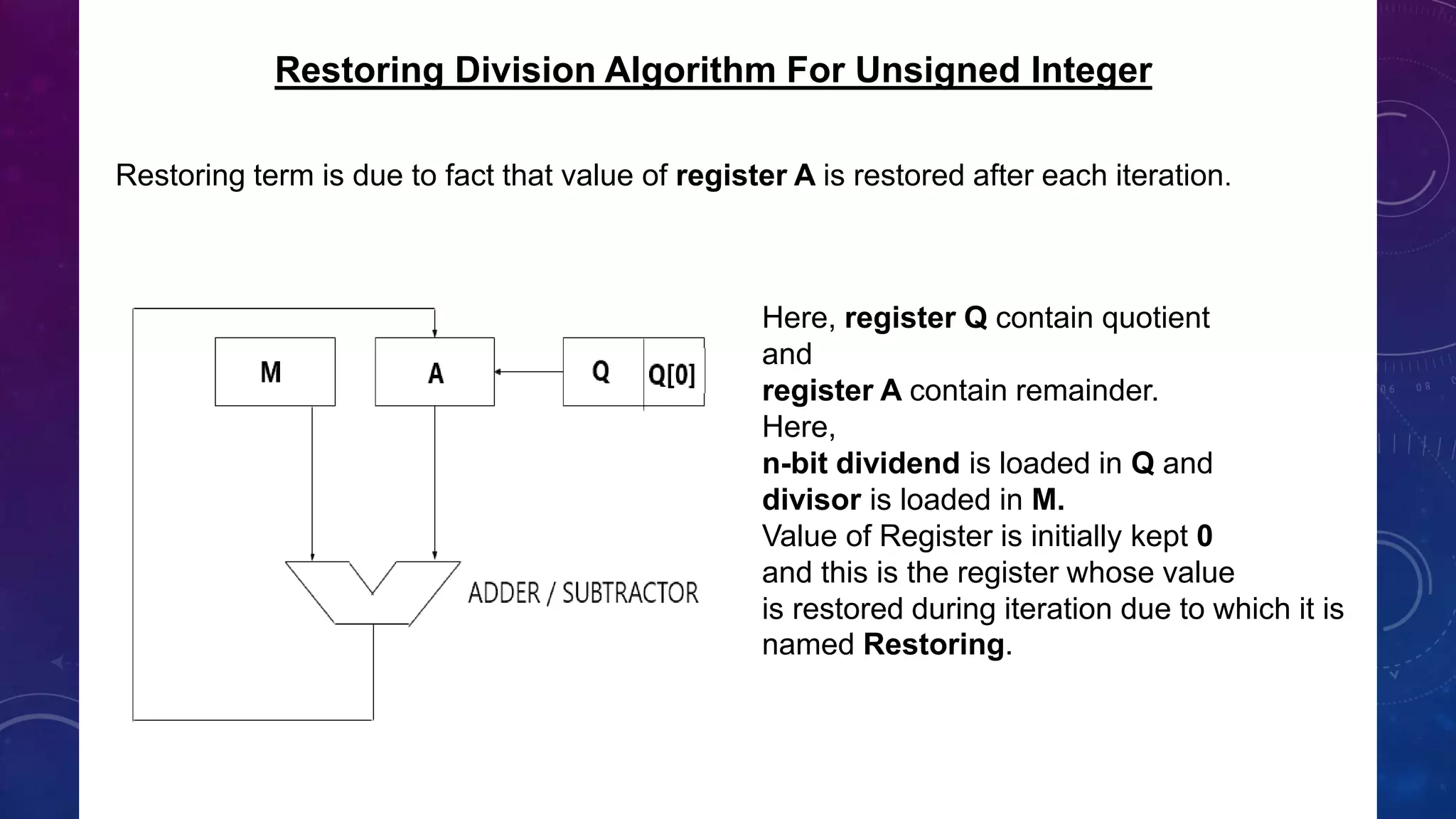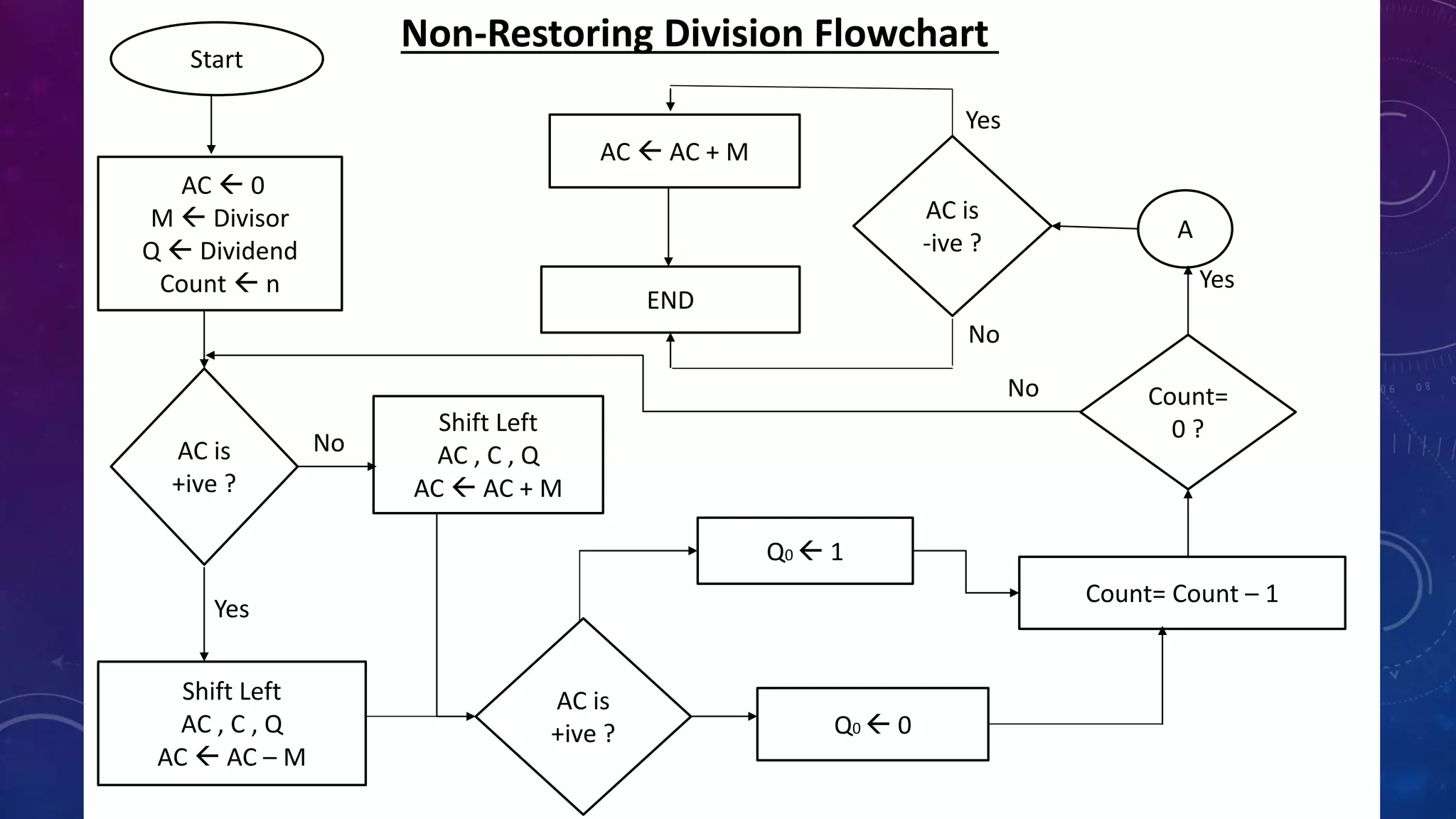The document discusses restoring and non-restoring division algorithms for unsigned integers in computer architecture. It outlines the steps involved in each algorithm, emphasizing differences such as the restoring steps in the restoring algorithm and the reliance on the sign bit in the non-restoring algorithm. Examples are provided to illustrate the implementation of both algorithms.





![N M A Q OPERATION
4 00011 00000 1011 initialize
00011 00001 011_ shift left AQ
00011 11110 011_ A=A-M
00011 00001 0110
Q[0]=0 And
restore A
N M A Q OPERATION
3 00011 00010 110_ shift left AQ
00011 11111 110_ A=A-M
00011 00010 1100 Q[0]=0
00011 00010 110_ shift left AQ](https://image.slidesharecdn.com/restoringnon-restoringdivisionalgorithms-200821091854/75/Restoring-Non-Restoring-Division-Algorithm-By-Sania-Nisar-6-2048.jpg)
![N M A Q OPERATION
2 00011 00101 100_ shift left AQ
00011 00010 100_ A=A-M
00011 00010 1001 Q[0]=1
00011 00101 100_ shift left AQ
N M A Q OPERATION
1 00011 00101 001_ shift left AQ
00011 00010 001_ A=A-M
00011 00010 0011 Q[0]=1
00011 00101 001_ shift left AQ](https://image.slidesharecdn.com/restoringnon-restoringdivisionalgorithms-200821091854/75/Restoring-Non-Restoring-Division-Algorithm-By-Sania-Nisar-7-2048.jpg)


![• Step-1: First the registers are initialized with corresponding values (Q = Dividend,
M = Divisor, A = 0, n = number of bits in dividend)
• Step-2: Check the sign bit of register A
• Step-3: If it is 1 shift left content of AQ and perform A = A+M, otherwise shift left AQ
and perform A = A-M (means add 2’s complement of M to A and store it to A)
• Step-4: Again the sign bit of register A
• Step-5: If sign bit is 1 Q[0] become 0 otherwise Q[0] become 1 (Q[0] means least
significant bit of register Q)
• Step-6: Decrements value of N by 1
• Step-7: If N is not equal to zero go to Step 2 otherwise go to next step
• Step-8: If sign bit of A is 1 then perform A = A+M
• Step-9: Register Q contain quotient and A contain remainder](https://image.slidesharecdn.com/restoringnon-restoringdivisionalgorithms-200821091854/75/Restoring-Non-Restoring-Division-Algorithm-By-Sania-Nisar-10-2048.jpg)
![Example:
Perform Non-Restoring Division for Unsigned Integer
Dividend =11 Divisor =3 -M =11101
• Step-1: First the registers are initialized with corresponding values (Q = Dividend, M =
Divisor, A = 0, n = number of bits in dividend)
• Step-2: Check the sign bit of register A
• Step-3: If it is 1 shift left content of AQ and perform A = A+M, otherwise shift left AQ and
perform A = A-M (means add 2’s complement of M to A and store it to A)
• Step-4: Again the sign bit of register A
• Step-5: If sign bit is 1 Q[0] become 0 otherwise Q[0] become 1 (Q[0] means least
significant bit of register Q)
• Step-6: Decrements value of N by 1](https://image.slidesharecdn.com/restoringnon-restoringdivisionalgorithms-200821091854/75/Restoring-Non-Restoring-Division-Algorithm-By-Sania-Nisar-11-2048.jpg)

![N M A Q ACTION
4 00011 00000 1011 Start
00001 011_ Left shift AQ
11110 011_ A=A-M
N M A Q ACTION
3 11110 0110 Q[0]=0
11100 110_ Left shift AQ
11111 110_ A=A+M](https://image.slidesharecdn.com/restoringnon-restoringdivisionalgorithms-200821091854/75/Restoring-Non-Restoring-Division-Algorithm-By-Sania-Nisar-13-2048.jpg)
![N M A Q ACTION
2 11111 1100 Q[0]=0
11111 100_ Left Shift AQ
00010 100_ A=A+M
N M A Q ACTION
1 00010 1001 Q[0]=1
00101 001_ Left Shift AQ
00010 001_ A=A-M
N M A Q ACTION
0 00010 0011 Q[0]=1](https://image.slidesharecdn.com/restoringnon-restoringdivisionalgorithms-200821091854/75/Restoring-Non-Restoring-Division-Algorithm-By-Sania-Nisar-14-2048.jpg)
